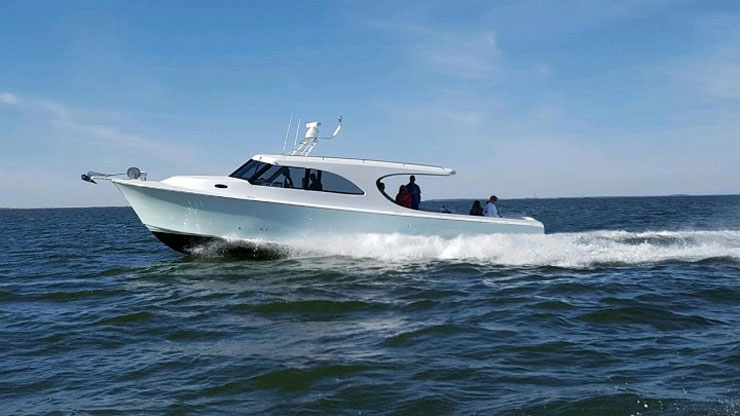The stripers are biting so gingerly that you need to set the hook at the slightest provocation, be on your toes at all times, and DANG IT! I just missed another one! That’s two in a row—and it’s all Jim Weaver’s fault. He just had to go and build the Weaver 43 Bay, and as it happens this bodacious Chesapeake Bay fantasy-boat is currently trolling about 100 yards off to my port. It’s way too distracting, and it seems like the fish know the difference between when I glance, and when I ogle. Ready for a close look of your own? Jump aboard as we sea trial a Weaver 43.
True, I had already seen the 43 Bay at the Bay Bridge Boat Show this spring. But when a boat like this sits in a slip, you don’t always feel the full effect. It looked good then, but out on the water seeing it is a completely different experience. You folks who were fishing just off the radar towers this spring, one afternoon right after the size limit dropped, know exactly what I’m talking about—and if any of you have a half a mill laying under your mattress, I’ll bet you were even more distracted than I was.

Looks alone does not, of course, make for a good boat. But boatbuilding experience is not exactly lacking when it comes to Weaver. This company is best known for crafting multi-million-dollar cold-molded sportfishing convertibles which offer performance that no production-built boats can match. Weight, as usual, is a big part of the equation. And although this boat is different from the usual Weaver it’s built with the same basic methods. The 43 Bay’s hull is cold-molded with nine-millimeter and 12-millimeter layers of Okume ply, the deck and top are cored with Nida-Core, and both are then fully encapsulated with fiberglass. As a result the 43 Bay tips the scales at 20,700 pounds fully loaded. Most production glass boats weigh in at between 25 and 50 percent more, without offering any additional strength.
The down-sides to building this way include increased built-time, and increased cost. If you were to order a new Weaver 43 Bay tomorrow, you wouldn’t be able to start hauling fish over the gunwales for about five months. When it comes to the cost factor, however, Weaver has found ways to mitigate the difference. For starters the interior isn’t quite as glamorous as on those sportfishers they’ve built in the past. Instead it’s a straight-forward, simple, somewhat Spartan arrangement with a teak interior and an Amtico sole in the cabin, a dinette and a compact galley to port, the helm station to starboard, a twin berth down in the lower cabin, and a stand-up head. The bottom line is also kept reasonable by powering with a single-screw 550-horsepower Cummins that provides a top end of 30 knots and a 25 knot cruise while burning just 18 gallons per hour. But if half a mil still sounds like an awful lot of dough consider this: a new EastBay 46, Tiara 4300 Open, Viking 42 Sport Yacht hard top express, and Wesmac 42 Sport all cost about twice that much.
After building all those uber-expensive sportfishing machines, why did Jim Weaver build a boat for the bay in the first place? “Those boats go all over the country—all over the world,” he said. “I rarely get to see them. I wanted to build a boat that would be appropriate for the Chesapeake, but one that was a class above other bay boats.”
Mission accomplished. And thanks to you and your boat, Jim, I just missed another striper.
Quick Facts:
- LOA – 43’3”
- Beam – 14’0”
- Displacement – 20,700 lbs.
- Draft (hull) – 3’0”
- Transom deadrise – 9 degrees
- Fuel Capacity –200 gal
- Max HP – NA
- Area Dealers – Weaver Boatworks, Deale, MD, (410) 867-8757.